Mercados
Al diseñar una intervención humanitaria y decidir si se utilizan los PTM, el análisis de mercado debe ser parte del análisis global de la respuesta. Se ha demostrado que apoyar a los mercados para que funcionen bien conduce a una recuperación más rápida y a una mayor resiliencia en zonas afectadas por desastres.
Muchas organizaciones han invertido en el desarrollo de herramientas de apoyo para el análisis de mercado y están considerando la programación basada en el mercado de forma más integral. Esto incluye intervenciones que utilizan los mercados (como las transferencias en efectivo a poblaciones afectadas), así como intervenciones que apoyan directamente a los mercados (como subvenciones condicionales a los comerciantes para recuperar su mercado y mantenerlos funcionando).
Iniciativas relacionadas
Contenido destacado

Introduction to Market Analysis
Curso
This 30 minute online course provides an introduction to the analysis of markets in emergency contexts, with input from some of the world’s leading thinkers on the topic.

A Practical Guide to Market Analysis in Humanitarian response
Curso
A three to four hour online course designed to provide future humanitarian market assessment team members with a solid understanding of theory and steps of market assessments so that they can join assessment teams prepared with a basic understanding of what they will be doing and why.
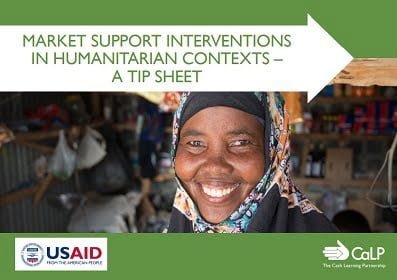
Market Support Interventions in Humanitarian Contexts – a Tip Sheet
Guidelines and Tools
This tip sheet defines what market support programming in humanitarian contexts is, and what it can look like in practice. It enables humanitarian practitioners to systematically consider market support interventions alongside other programme activities. The scope includes support interventions focusing on supply/availability and on demand/access. The tip sheet is based on secondary data...
Líder temático
Últimos recursos

Marco de Información de Mercado
Guía y herramientas
Este marco tiene como objetivo desmitificar y simplificar el análisis de mercado centrado en la emergencia al (1) explicar de manera clara las preguntas más comunes relacionadas con la programación de la respuesta humanitaria para lo cual se necesita información del mercado; (2) indicar qué tipos de...
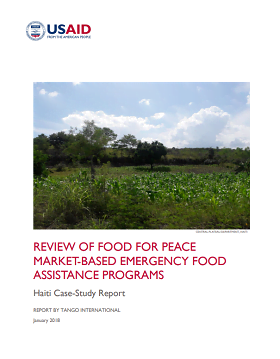
Review of Food for Peace Market-Based Emergency Food Assistance Programs: Haiti Case-Study Report
Report
Haiti is a very low-income country with a degraded ecological setting that faces repeated threats from multiple hazards. It is an excellent example of Food for Peace (FFP) linking emergency and development funding through the Kore Lavi Title II program that serves as a model for the national social...

Análisis de Mercado Más Allá de la Teoría: Prácticas que facilitan el uso de la información de mercado en la programación humanitaria
Guía y herramientas
En el proyecto Improving the Uptake of Market Analysis (Mejoramiento de la aceptación del análisis de mercado humanitario), un esfuerzo financiado por USAID/OFDA que conduce el IRC en asociación con Mercy Corps y CRS, el IRC revisó la programación existente en respuesta al mercado para extraer y...

Review of Food for Peace Market-Based Emergency Food Assistance Programs: Jordan/Turkey Case Study Report
Report
Syria regional crisis: The response to the Syria regional crisis exemplifies the challenges and opportunities involved with delivering food assistance in a widespread, largely urban refugee and internally displaced persons (IDP) crisis affecting middle-income countries. This case study focuses on...

Breve Informe de la Evaluación: Experiencia y aprendizaje de las pruebas piloto de buenas prácticas en el análisis de mercado para respuestas humanitarias
Guía y herramientas
A través del proyecto Improving the Uptake of Humanitarian Market Analysis (Mejoramiento de la aceptación del análisis de mercado para respuestas humanitarias), el IRC tuvo como objetivo ayudar a facilitar el uso sistemático de la información del mercado para la programación de la respuesta...

Review of Food for Peace Market-Based Emergency Food Assistance Programs: Kenya Case Study Report
Report
Kenya represents a country focused on building resilience through greater partnerships between USAID-Food for Peace (FFP) programs, other USAID-funded programs and local and national government. DESIGN: FFP MBEP in Kenya is a good example of connecting emergency and development programming and of...

Cost-Effectiveness in Humanitarian Work: Cash-Based Programming
Report
There is consensus in the literature that giving people cash in humanitarian contexts provides greater choice and dignity while at the same time stimulating local markets. In comparison to in-kind approaches, cash emerges as more efficient to deliver and – depending on the particularities of a given...

Review of Food for Peace Market-Based Emergency Food Assistance Programs: Nigeria Case Study Report
Case Study
Nigeria is an example of food assistance in a conflict situation in the Sahelian context. The response used information technology to deliver one of the more sophisticated applications of voucher programs. This case is a good example of proactive implementing partner (IP) mechanisms and monitoring systems...

Market Systems in Libya: Assessment of the Wheat Flour, Insulin, Tomato and Soap Supply Chains
Report
The Market Systems in Libya assessment aims to provide humanitarian organisations with a better understanding of market dynamics in Libya, information on key supply chains and how they have been impacted by ongoing conflict, and the necessary foundation to examine the potential of scaling up market and...

UNHCR Multi-Sector Market Assessment (MSMA): Charcoal, water, low-income rental housing and core-relief items in Maiduguri, Jere and Konduga, Borno State, Nigeria
Report
To assess the capacity of markets to respond to cash based initiatives (CBI), including multi-purpose cash grants (MPG), the UNHCR Multi-Sector Market Assessment (MSMA) was piloted in Maiduguri Municipal Council (MMC), Jere and Konduga Local Government Areas (LGAs) of Borno State, Nigeria in July 2017....

Libya Cash and Markets Working Group (CMWG) Advocacy and Communications Plan
Report
The Libya Cash & Markets Working Group (CMWG) Strategic Framework & 2017 Workplan outlines ‘communication and advocacy’ as a ‘deliverable’ for supporting ‘HC/HCT decision making’.
Throughout March & April 2017, the CMWG Steering Committee used a series of tools as part of a seven-step process...
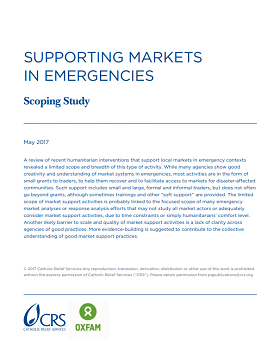
Supporting markets in emergencies. Scoping study
Report
A review of recent humanitarian interventions that support local markets in emergency contexts revealed a limited scope and breadth of this type of activity. While many agencies show good creativity and understanding of market systems in emergencies, most activities are in the form of small grants to...

Cash and Markets Monthly Dashboard DRAFT April 2017
Guidelines and Tools
• The cash and markets, monthly dashboard presents current data on market prices of key commodities and the cost of the minimum expenditure basked (MEB) across Somalia. In addition, it also provides key highlights relevant to cash and market interventions.
• Page one presents the cost of the food MEB...
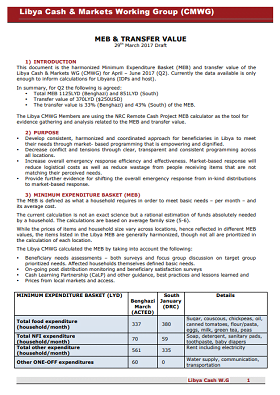
MEB and Transfer Value Guide
Guidelines and Tools
This document is the harmonized Minimum Expenditure Basket (MEB) and transfer value of the Libya Cash & Markets WG (CMWG) for April – June 2017 (Q2). Currently the data available is only enough to inform calculations for Libyans (IDPs and host).
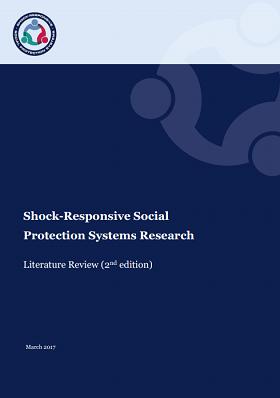
Shock-Responsive Social Protection Systems Research: Literature Review (2nd Edition)
Report
DFID has commissioned research into Shock-Responsive Social Protection systems, to further understand the nature of the interaction between social protection, humanitarian and disaster risk management systems and ways in which long-term social protection systems can be scaled up to provide support in...
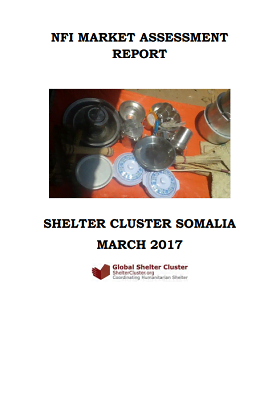
NFI Market Assessment Report – Somalia
Report
The Shelter Cluster, through its regional coordinators rolled out NFI market assessments in six towns including Mogadishu, Kismayo, Bossaso, Baidoa and Dobley through a rapid mobile technology based market survey tool. The purpose of the survey was to establish where NFI markets exist and what items are...

Fitting aid to context: community experiences of aid delivery in northern Syria
Report
The ongoing conflict in Syria has left 13.5 million Syrians in need of humanitarian assistance. Several local and international organisations provide aid to northern Syria, but their chosen modalities fail to effectively meet community members’ needs. While aiming to respond to immediate short-term...

Aid in context: the importance of market-based approaches to aid delivery in northern Syria
Report
With the Syrian conflict now in its seventh year, 13.5 million Syrians need humanitarian aid. But aid in northern Syria focuses inflexibly on food kits that are expensive to administer, designed to satisfy short-term needs.
Many people sell their food aid to pay for other urgent needs. This
undermines...

Interim Guidance Note on Determining Cash Transfers Values for Food Security
Guidelines and Tools
The objective of this guidance note, as laid out in the Terms of Reference, is to: Leverage FSC partners’ knowledge and experience to develop guidance on cash transfer value logic for both unconditional and relevant food security cash for work/assets3 programming. It focusses on acute food insecurity...

Improving the Uptake of Humanitarian Market Analysis
Guidelines and Tools
Market assessments and market-based programming are now widely considered best practice in humanitarian programming, especially among food security and livelihoods actors. They are embedded in various standard-bearing initiatives, and there are a number of tools for emergency market analysis and...



